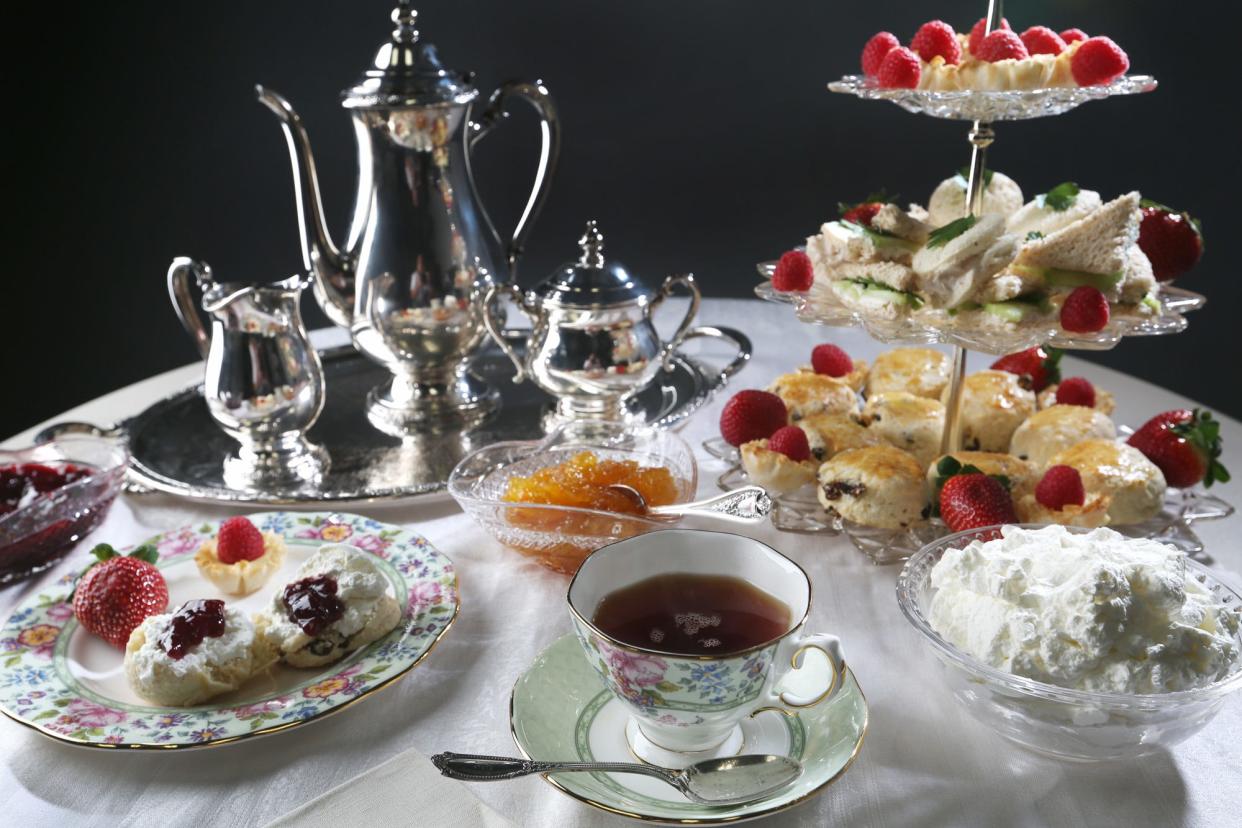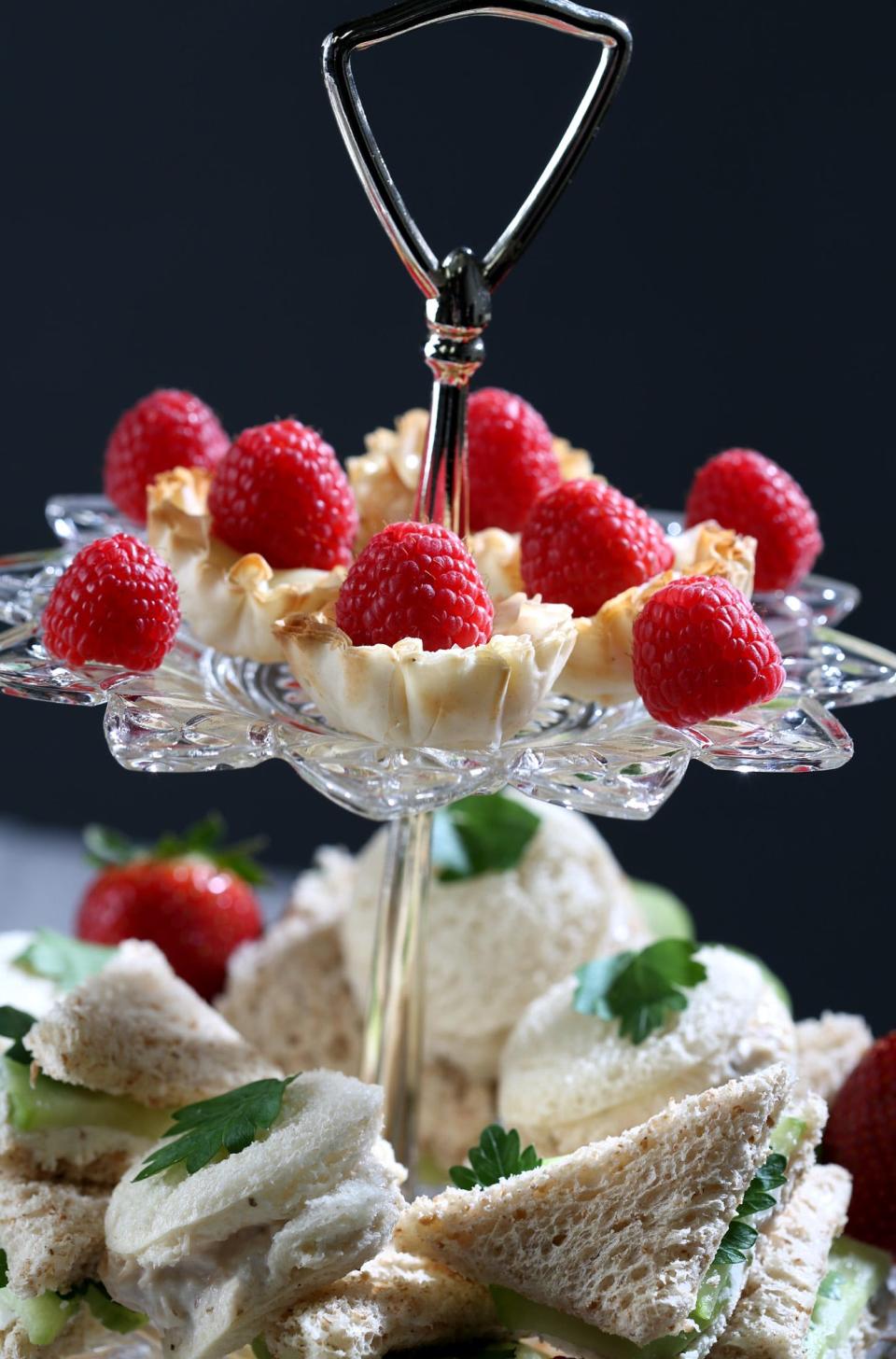Tart, scone recipes for afternoon tea to put you in mood for 'Downton Abbey: A New Era'

Editor's note: With the release of the new "Downton Abbey: A New Era" film this week, we thought it would be fun to bring back a story and recipes from the Dispatch archive. The content was written by then-food editor Lisa Abraham and published in January 2015.
Enjoy!
Which suitor will Lady Mary choose? What will become of Lady Edith's baby? And who will be struck by the next zinger from the Dowager Countess?
It's time to step back in history and settle into a new season of "Downton Abbey."
With its elaborate period clothes; fine furnishings; and, of course, perfect afternoon tea, the PBS drama promises to keep viewers intrigued this winter.
Life at the abbey isn't all period fiction, though.
Those elaborate tea services remain a part of daily life for British aristocracy, according to one-time royal chef Darren McGrady.
McGrady spent 11 years in the kitchen at Buckingham Palace and four years as a personal chef to Princess Diana and Princes William and Harry before moving to Texas after her death in 1997.
He works in Dallas as a private chef through his business, the Royal Chef.
"It's interesting: People talk to me about 'Downton Abbey' all the time, and I tell them, ‘It's not a period drama; it still goes on today in Buckingham Palace,'" McGrady said. "That stopping for tea and dressing for dinner still go on today."
The popularity of the show (which at the time had just begun its fifth season), is credited with heightening interest in afternoon tea.
"There is no question of that," said Anand Saha, owner of Mozart's Restaurant, Bakery and Piano Cafe in the Clintonville neighborhood.
Outdoor movies: Easton Town Center to host Movies by Moonlight series, showing four free outdoor movies
"We absolutely are seeing an increasing number of people wanting to have tea."
Mary Boesch, owner of Cambridge Tea House in Marble Cliff and herself a "Downton" fan, said customers enjoy experiencing tea in a more formal setting, similar to how they see it depicted on the series.
"We tend to think of tea as a little more refined," she said. "When we have tea, we often sit with friends and linger."
A proper afternoon tea, Boesch said, follows certain rules, beginning with some regarding the tea itself:
• Use a high-quality loose-leaf tea, she said.
• Start with icy cold water and draw it to the proper temperature to draw out the tea's best flavor. For black teas, a temperature just under boiling is appropriate, she said; and for more delicately flavored white and green teas, a slightly lower temperature.
• Always start with fresh water; don't reboil cooled water.
"Fresh water has more oxygen in it," she said. "Water that has been boiled many times will make tea that tastes flat."
Boesch also scalds the inside of her teapots with boiling water to warm them before placing the tea inside.
Earl Grey, English Breakfast, peppermint and raspberry are favorite tea varieties among Mozart's customers, Saha said.
Scones are a must for serving with formal tea, as are small tea sandwiches and other sweet cakes, Saha said.
'Doctor Strange': 'Doctor Strange in the Multiverse of Madness' is showing; here's where to see the flick
McGrady, who chronicles his time in the royal kitchens in the 2007 cookbook Eating Royally, said kitchen staff members prepared scones for Queen Elizabeth II's daily afternoon tea, including raisins in the recipe every other day.
The queen never ate the scones, he recalled; she crumbled one or two on the carpet for her corgis to enjoy.
McGrady described three types of English teas, with afternoon tea being the most popular — and the one typically depicted on "Downton."
Cream tea, a version of afternoon tea, takes its name from the clotted cream served to accompany the scones, he said.
At afternoon tea, scones are served warm with butter and jam. At a cream tea, the scones are served at room temperature with jam and clotted cream -- a thick cream that, with 47 percent butterfat, can be spread with a spoon.
Traditional clotted cream comes from the Cornwall region of England; a similar version from Devonshire is known as Devonshire cream, McGrady explained.
The term high tea, which Americans often confuse with a fancy afternoon tea, is actually used to describe a casual supper served to servants or royal children.
"Children have high tea at 6 p.m. with more traditional children's foods, like chicken fingers," McGrady said.
The term reflects how the tea is taken at high chairs around a table instead of in a parlor where traditional afternoon tea is served.
Afternoon tea is offered with sugar cubes, cold milk (never cream) or thin slices of lemon as accompaniments.
Other items served at afternoon tea, McGrady said, include a large cake for slicing as well as smaller one- or two-bite sweets such as tartlets, madeleines or eclairs.
Completing the tea service are small sandwiches, always with the crusts trimmed from the bread, he said.
Two types of tea sandwiches — one on white bread, the other on wheat — were always offered to the royals, McGrady said. The traditional fillings — cucumber and cream cheese, ham and cheese, smoked salmon or chicken — would change daily.
Palace chefs always buttered the bread first to create a barrier between the bread and the filling to keep the bread from getting soggy, he noted.
Tea sandwiches might be cut into octagons, circles or triangles — but not rectangles, McGrady said.
Presenting anything rectangular (a shape reminiscent of a coffin) to the queen, he said, is considered a terrible faux pas — akin to wishing death to the monarch.
ROYAL TEA SCONES
Makes 16
Recipe from Eating Royally (2007) by Darren McGrady
Heat oven to 350 degrees. Combine the flour, sugar and baking powder in a large bowl. Cut in the butter and stir until the flour mixture resembles fine breadcrumbs. Make a well in the center of the mixture and add the beaten egg and about 3/4 cup of milk. Add the raisins now if making a fruit scone. Bring the mixture together with a metal spoon, making sure not to overmix and toughen the dough. If the mixture seems dry and crumbly, add more of the remaining milk, but add it gradually. You want a lightly bound dough that is neither too wet nor too dry.
Lightly dust a cutting board with flour, and roll out the dough to about 1 inch thick. Then, using a 2-inch round cookie cutter, cut out about 16 scones and place them on an ungreased baking sheet about 1 inch apart. Brush the tops of the scones with the beaten egg yolk.
Bake for 15 to 20 minutes, or until scones are lightly colored. Serve hot or transfer scones to a cooling rack.
Note: Extra-fine sugar is often labeled superfine sugar. If you can't find it, substitute regular granulated white sugar.
PER SERVING: 216 calories, 4 g protein, 36 g carbohydrates, 1 g fiber, 14 g sugar, 7 g fat (4 g saturated), 30 mg cholesterol, 151 mg sodium

VANILLA TARTLETS
Makes 30
Filling adapted from Betty Crocker Cookbook
Prepare the filling by combining the sugar, cornstarch and salt in a 2-quart saucepan. Combine milk and egg yolks.
Gradually stir milk mixture into sugar mixture. Cook over medium heat, stirring constantly, until mixture thickens and boils. Boil for 1 minute, stirring constantly. Remove from heat. Stir in butter and vanilla.
Cool slightly.
Spoon filling into prepared shells. Refrigerate until set. When set and cold, top each with a raspberry. Dust with confectioners' sugar, if desired.
PER SERVING: Nutritional information can't be calculated for this recipe.
CUCUMBER TEA SANDWICHES
Makes 8 sandwiches
Apply cheese spread to 2 slices of bread. Top with cucumber slices and parsley leaves or watercress.
Top with remaining 2 slices of bread.
Cut each sandwich into 4 triangles.
PER SERVING: Nutritional information can't be calculated for this recipe.
CHICKEN-SPREAD TEA SANDWICHES
Makes 8 to 12 sandwiches
Place all ingredients except bread in a bowl. Using an electric mixer, beat on low speed until well-combined.
Apply chicken spread to 4 of the bread slices (see note). Top with remaining 4 slices of bread.
Using a small round cookie cutter, cut each into small circles. You will get about 2 or 3 from each, depending on the size of the bread and the size of the cutter used.
Note: You will have enough chicken spread remaining to make additional sandwiches, if you desire. Otherwise, the leftover spread is good on crackers.
PER SERVING: Nutritional information can't be calculated for this recipe.
This article originally appeared on The Columbus Dispatch: Scones, tarts, sandwiches: Recipes for Downton Abbey afternoon tea

